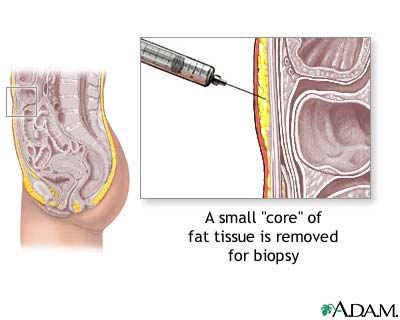Health Library
Abdominal wall fat pad biopsy
Amyloidosis - abdominal wall fat pad biopsy; Abdominal wall biopsy; Biopsy - abdominal wall fat pad
An abdominal wall fat pad biopsy is the removal of a small part of the abdominal wall fat pad for laboratory study of the tissue.
Images


I Would Like to Learn About:
How the Test is Performed
Needle aspiration is the most common method of taking an abdominal wall fat pad biopsy.
The health care provider cleans the skin on your belly area. Numbing medicine will be applied on or injected into the area. A needle is placed through the skin and into the fat pad under the skin. A small piece of the fat pad is removed with the needle. It is sent to a laboratory for analysis.
How to Prepare for the Test
No special preparation is usually necessary. However, follow any specific instructions your provider gives you.
How the Test will Feel
You may have some mild discomfort or feel pressure when the needle is inserted. Afterward, the area may feel tender or be bruised for several days.
Why the Test is Performed
The procedure is done most often to test for amyloidosis. Amyloidosis is a disorder in which abnormal proteins build up in tissues and organs, impairing their function. Clumps of the abnormal proteins are called amyloid deposits.
Diagnosing the disease in this way may avoid the need for a biopsy of a nerve or an internal organ, which is a more difficult procedure.
Normal Results
The fat pad tissues are normal.
What Abnormal Results Mean
In the case of amyloidosis, abnormal results mean there are amyloid deposits.
Risks
There is a slight risk for infection, bruising, or slight bleeding.
Related Information
Primary amyloidosisReferences
Gertz MA. Amyloidosis. In: Goldman L, Schafer AI, eds. Goldman-Cecil Medicine. 26th ed. Philadelphia, PA: Elsevier; 2020:chap 179.
BACK TO TOPReview Date: 2/28/2023
Reviewed By: Jacob Berman, MD, MPH, Clinical Assistant Professor of Medicine, Division of General Internal Medicine, University of Washington School of Medicine, Seattle, WA. Also reviewed by David C. Dugdale, MD, Medical Director, Brenda Conaway, Editorial Director, and the A.D.A.M. Editorial team.
 | A.D.A.M., Inc. is accredited by URAC, for Health Content Provider (www.urac.org). URAC's accreditation program is an independent audit to verify that A.D.A.M. follows rigorous standards of quality and accountability. A.D.A.M. is among the first to achieve this important distinction for online health information and services. Learn more about A.D.A.M.'s editorial policy, editorial process and privacy policy. A.D.A.M. is also a founding member of Hi-Ethics. This site complies with the HONcode standard for trustworthy health information: verify here. |
The information provided herein should not be used during any medical emergency or for the diagnosis or treatment of any medical condition. A licensed medical professional should be consulted for diagnosis and treatment of any and all medical conditions. Links to other sites are provided for information only -- they do not constitute endorsements of those other sites. No warranty of any kind, either expressed or implied, is made as to the accuracy, reliability, timeliness, or correctness of any translations made by a third-party service of the information provided herein into any other language. © 1997- 2024 A.D.A.M., a business unit of Ebix, Inc. Any duplication or distribution of the information contained herein is strictly prohibited.
